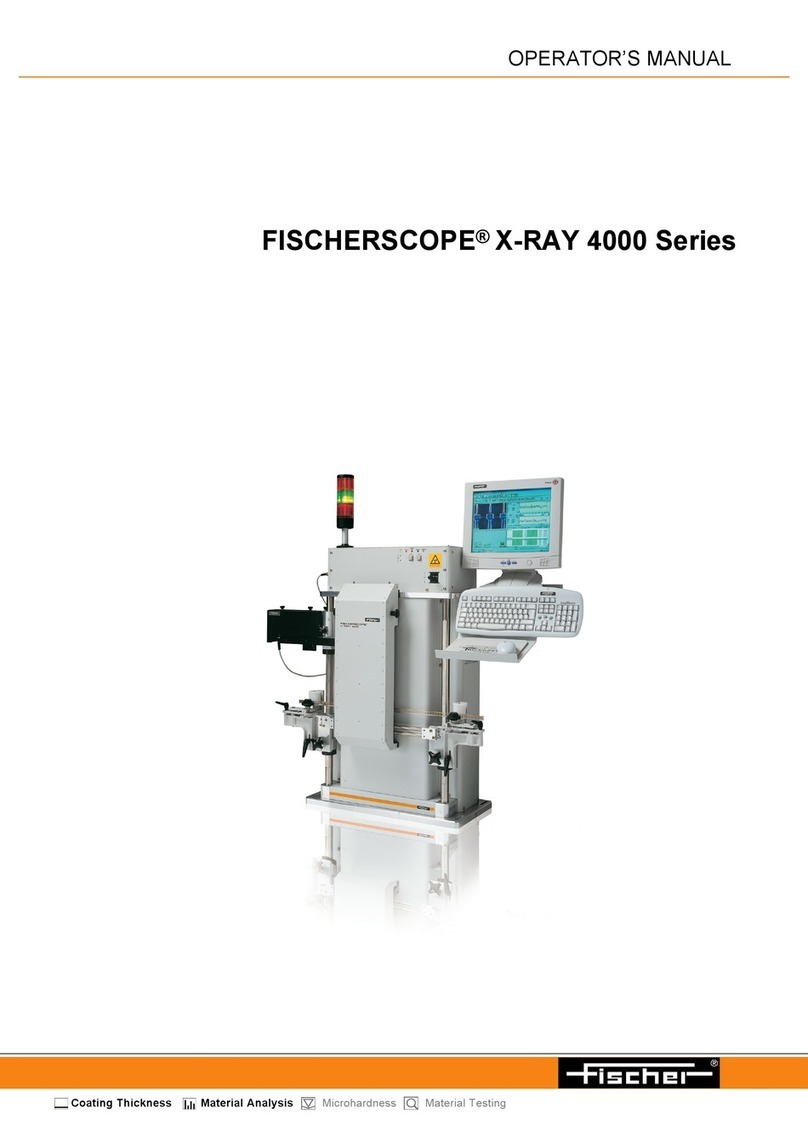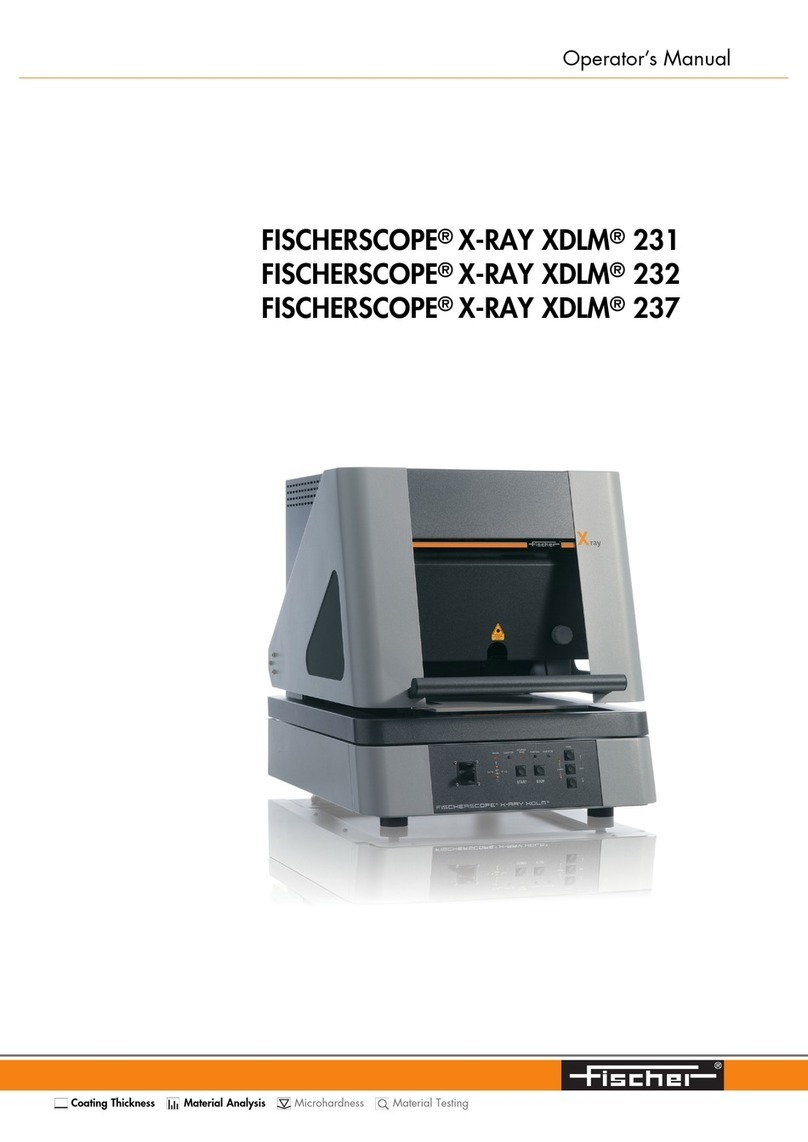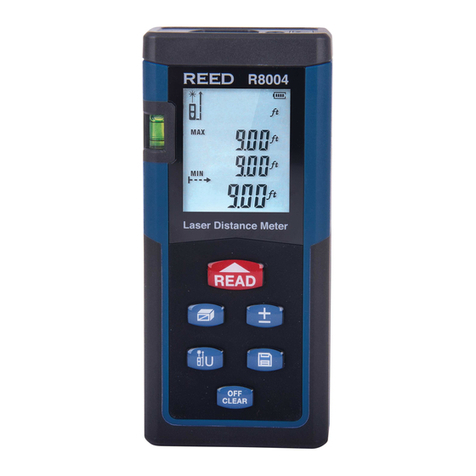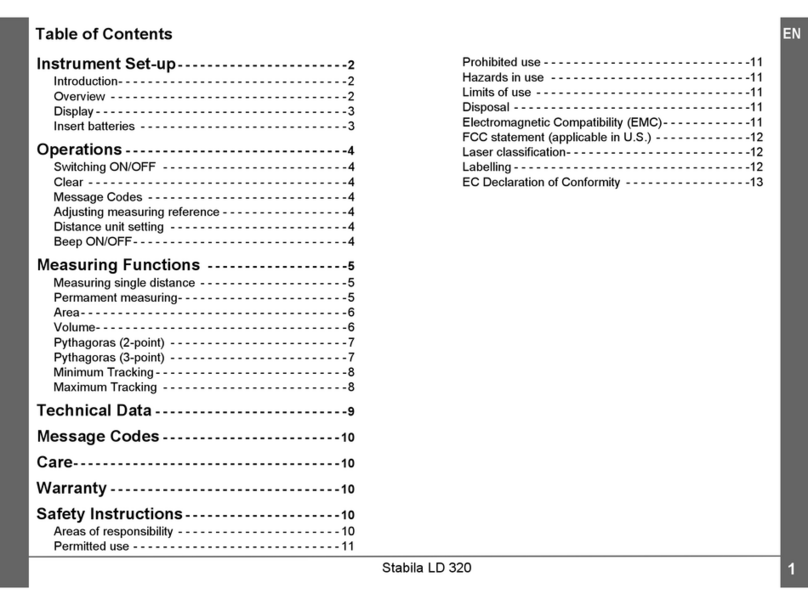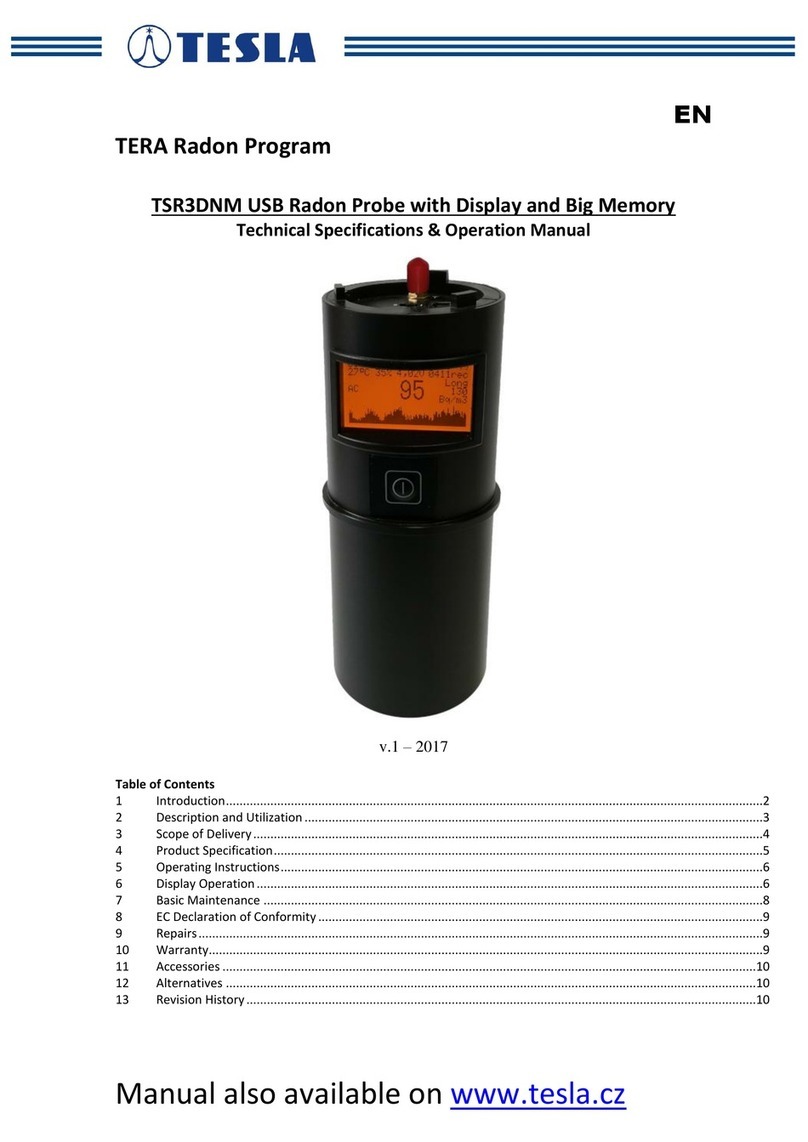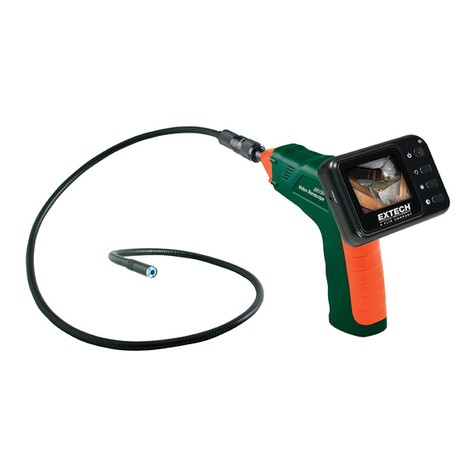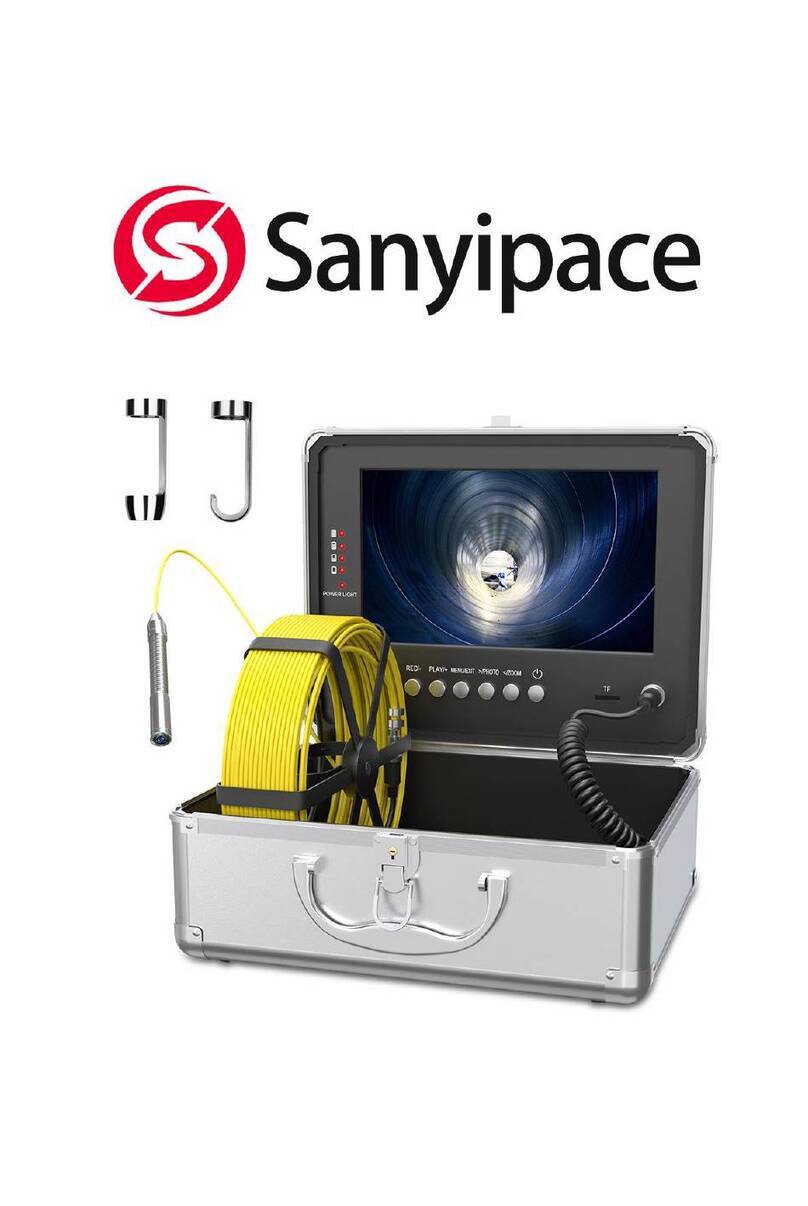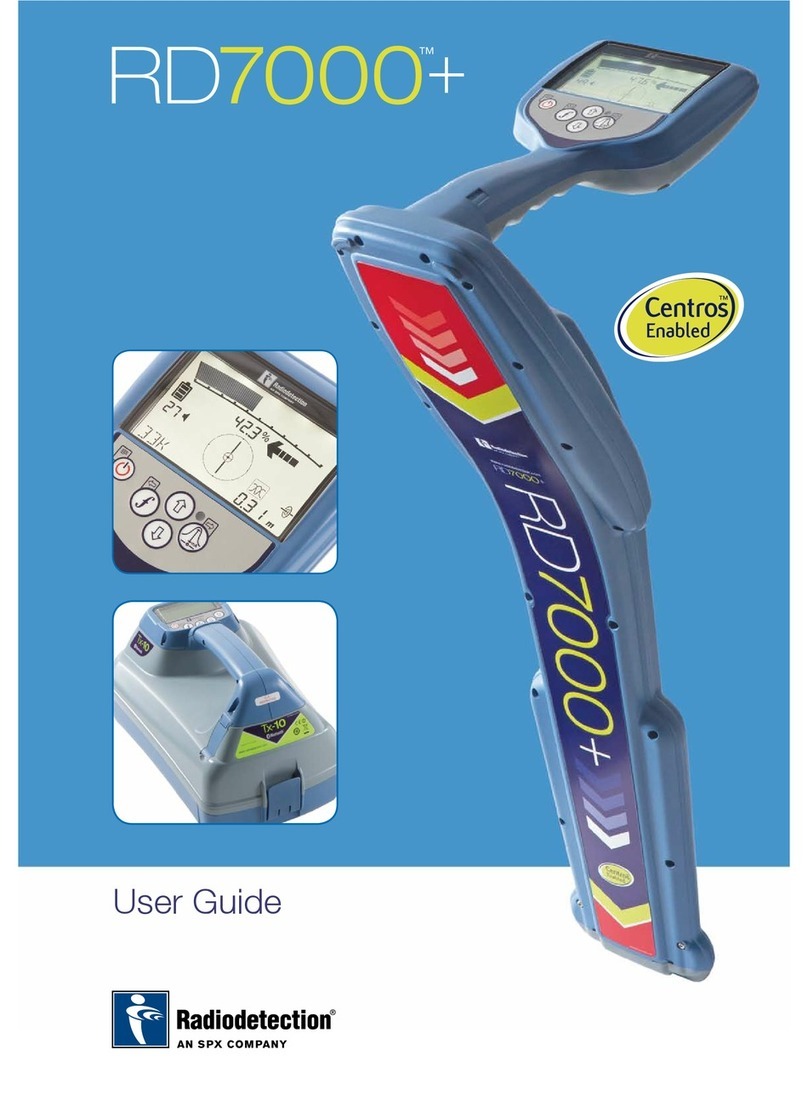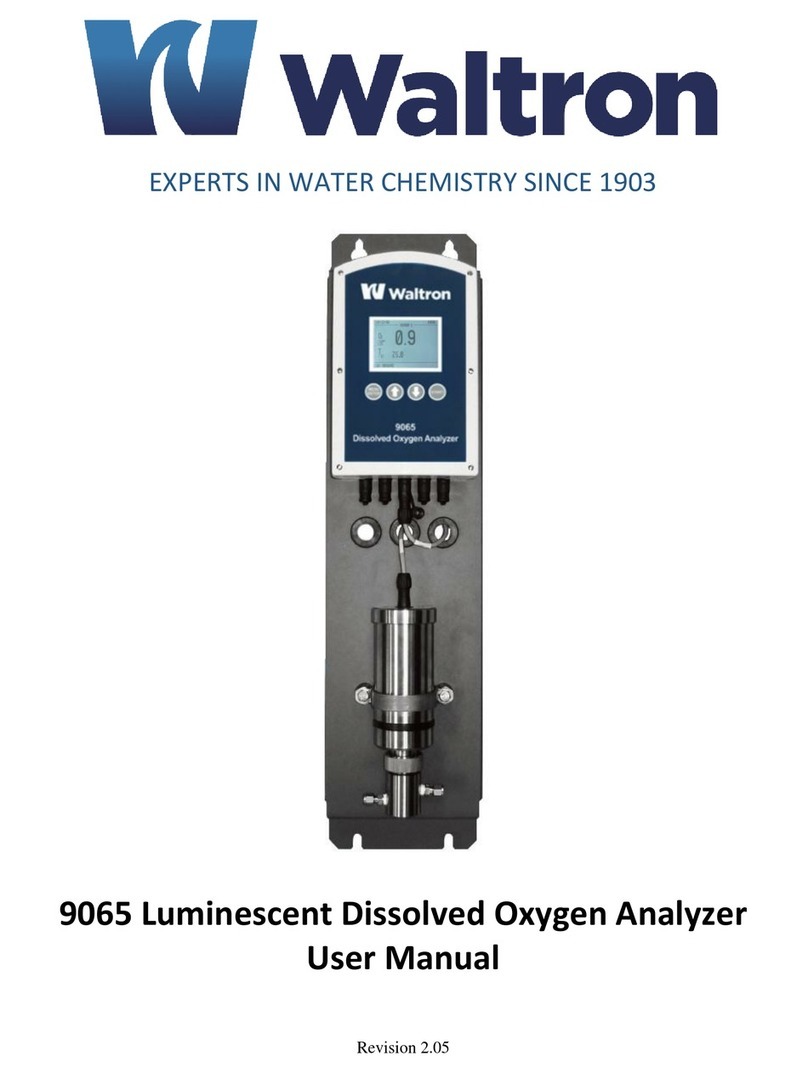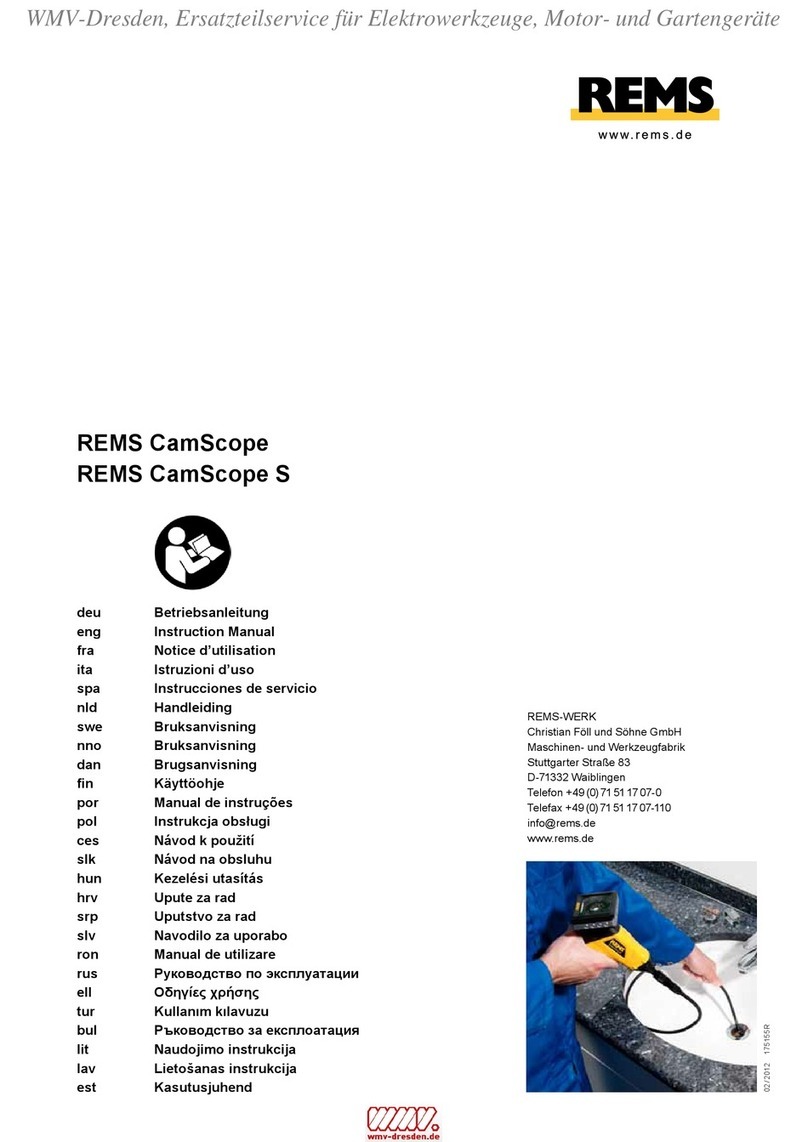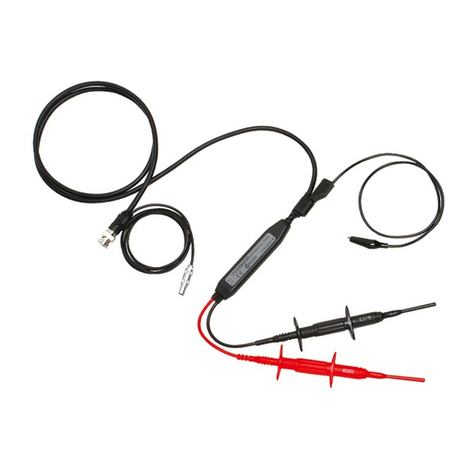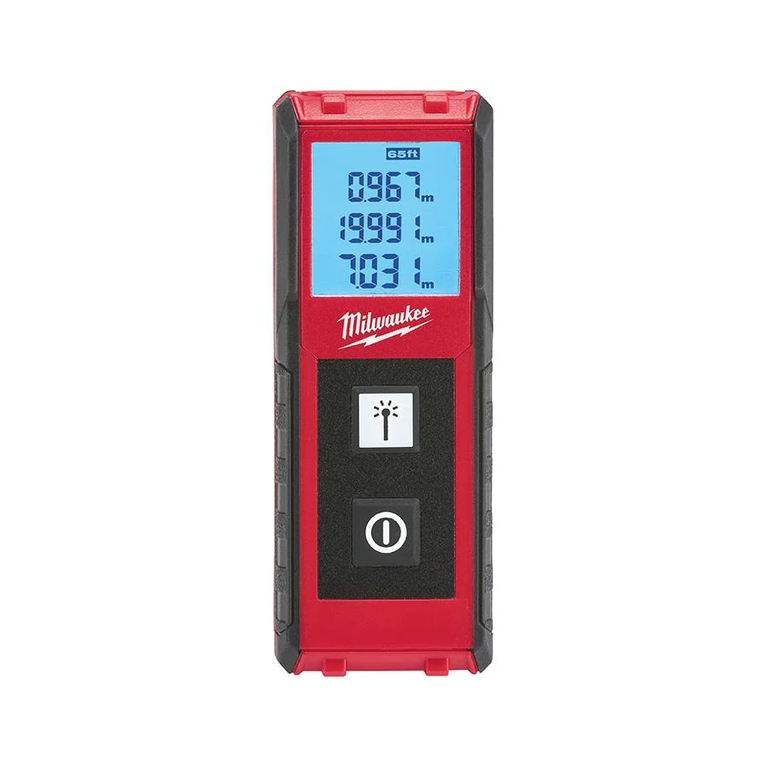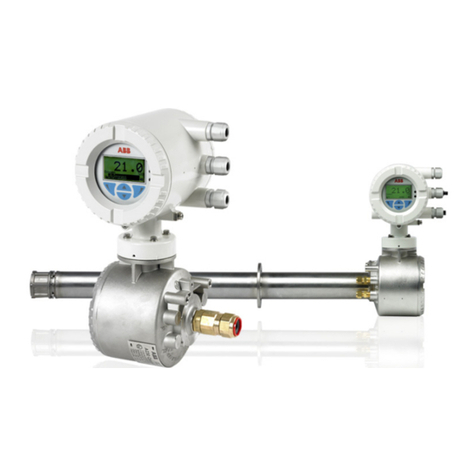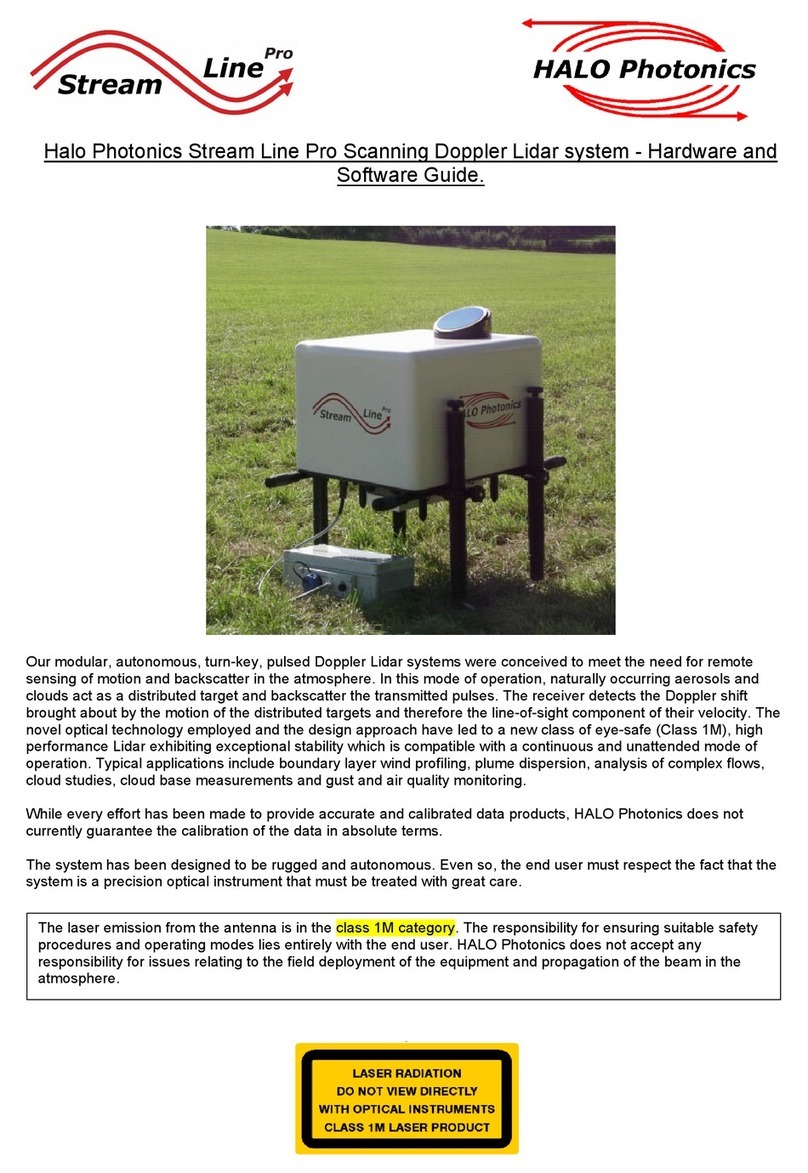FISCHER FISCHERSCOPE X-RAY 5000 Series User manual

OPERATOR’S MANUAL
Coating Thickness Material Analysis Microhardness Material Testing
FISCHERSCOPE® X-RAY 5000 Series

Operator’s Manual
FISCHERSCOPE®X-RAY 5000
X-ray fluorescence (EDXRF) measuring instrument
For coating thickness measurements and materials analysis according to the energy
dispersive X-ray fluorescence method
On our home page www.helmut-fischer.com you will find the addresses of our sole agen-
cies and subsidiary companies around the globe.
© 2012 by Helmut Fischer GmbH Institut für Elektronik und Messtechnik, Germany.
This operator’s manual remains the copyrighted property of Helmut Fischer GmbH. All
rights reserved. This manual may not be reproduced by any means (print, photocopy,
microfilm or any other method) in full or in part, or processed, multiplied or distributed to
third parties by electronic means without the written consent of Helmut Fischer GmbH.
Subject to correction and technical changes.
Document order number: 952-588
Issue date: 05. April 2012
Manufacturer
Helmut Fischer GmbH Phone: +49 (0) 70 31 3 03 - 0
Institut für Elektronik und Messtechnik Fax: +49 (0) 70 31 3 03 - 710
Industriestraße 21 www.helmut-fischer.com
Quality Assurance System of the Helmut Fischer GmbH
DIN EN ISO 9001:2008 Management system certified by Germanischer Lloyd
Systems Certification
DIN ISO/IEC 17025 Calibration lab accredited for certified mass per unit area
standards

FISCHERSCOPE®X-RAY 3
Table of Contents
Table of Contents
1 Safety Information . . . . . . . . . . . . . . . . . . . . . . . . . . . . . . . . . . . . . . . . 7
1.1 Intended Use . . . . . . . . . . . . . . . . . . . . . . . . . . . . . . . . . . . . . . . . . . . . . . . . . . .7
1.2 Safety of the Electrical Equipment. . . . . . . . . . . . . . . . . . . . . . . . . . . . . . . . . . .7
1.3 Maintenance and Repair . . . . . . . . . . . . . . . . . . . . . . . . . . . . . . . . . . . . . . . . . .7
1.4 X-Radiation Safety. . . . . . . . . . . . . . . . . . . . . . . . . . . . . . . . . . . . . . . . . . . . . . .8
1.5 Requirements for the Operating Personnel . . . . . . . . . . . . . . . . . . . . . . . . . . . .9
2 Instrument Overview . . . . . . . . . . . . . . . . . . . . . . . . . . . . . . . . . . . . . 11
2.1 Areas of Application. . . . . . . . . . . . . . . . . . . . . . . . . . . . . . . . . . . . . . . . . . . . .11
2.2 X-Ray Fluorescence . . . . . . . . . . . . . . . . . . . . . . . . . . . . . . . . . . . . . . . . . . . .12
2.3 Functional Principle of the Instrument . . . . . . . . . . . . . . . . . . . . . . . . . . . . . . .13
3 Switching the Instrument on and off. . . . . . . . . . . . . . . . . . . . . . . . . 15
3.1 Switching on the Instrument . . . . . . . . . . . . . . . . . . . . . . . . . . . . . . . . . . . . . .15
3.2 Switching off the Instrument . . . . . . . . . . . . . . . . . . . . . . . . . . . . . . . . . . . . . .16
3.3 Communication between Instrument and WinFTM. . . . . . . . . . . . . . . . . . . . . .17
4 Performing Manual Measurements . . . . . . . . . . . . . . . . . . . . . . . . . . 19
4.1 Deleting Measurement Readings. . . . . . . . . . . . . . . . . . . . . . . . . . . . . . . . . . .20
5 User Interface of the WinFTM Software . . . . . . . . . . . . . . . . . . . . . . 23
5.1 WinFTM Main Window. . . . . . . . . . . . . . . . . . . . . . . . . . . . . . . . . . . . . . . . . . .23
5.2 Video Image . . . . . . . . . . . . . . . . . . . . . . . . . . . . . . . . . . . . . . . . . . . . . . . . . .25
5.3 Statistics Field . . . . . . . . . . . . . . . . . . . . . . . . . . . . . . . . . . . . . . . . . . . . . . . . .27
5.4 Measurement Value Field . . . . . . . . . . . . . . . . . . . . . . . . . . . . . . . . . . . . . . . .27
5.5 Status Bar . . . . . . . . . . . . . . . . . . . . . . . . . . . . . . . . . . . . . . . . . . . . . . . . . . . .30
5.6 mq Value . . . . . . . . . . . . . . . . . . . . . . . . . . . . . . . . . . . . . . . . . . . . . . . . . . . . .30
5.7 Limited Operating Mode - Short menu. . . . . . . . . . . . . . . . . . . . . . . . . . . . . . .32
5.8 The Spectrum Window . . . . . . . . . . . . . . . . . . . . . . . . . . . . . . . . . . . . . . . . . .33

4FISCHERSCOPE®X-RAY
Table of Contents
6 WinFTM File Structure . . . . . . . . . . . . . . . . . . . . . . . . . . . . . . . . . . . . 37
6.1 Def.MA . . . . . . . . . . . . . . . . . . . . . . . . . . . . . . . . . . . . . . . . . . . . . . . . . . . . . .38
6.2 Measurement Application . . . . . . . . . . . . . . . . . . . . . . . . . . . . . . . . . . . . . . . .38
6.3 Product . . . . . . . . . . . . . . . . . . . . . . . . . . . . . . . . . . . . . . . . . . . . . . . . . . . . . .38
7 Product Administration . . . . . . . . . . . . . . . . . . . . . . . . . . . . . . . . . . . 41
7.1 Product . . . . . . . . . . . . . . . . . . . . . . . . . . . . . . . . . . . . . . . . . . . . . . . . . . . . . .41
7.2 Setting up a new product. . . . . . . . . . . . . . . . . . . . . . . . . . . . . . . . . . . . . . . . .41
7.3 Importing a product . . . . . . . . . . . . . . . . . . . . . . . . . . . . . . . . . . . . . . . . . . . . .42
7.4 Modifying products . . . . . . . . . . . . . . . . . . . . . . . . . . . . . . . . . . . . . . . . . . . . .43
7.5 Deleting products. . . . . . . . . . . . . . . . . . . . . . . . . . . . . . . . . . . . . . . . . . . . . . .43
7.6 Assigning a new measurement application to a product . . . . . . . . . . . . . . . . .44
7.7 Modify Measurement Application . . . . . . . . . . . . . . . . . . . . . . . . . . . . . . . . . . .44
7.8 Copy measurement application . . . . . . . . . . . . . . . . . . . . . . . . . . . . . . . . . . . .44
7.9 Delete measurement application . . . . . . . . . . . . . . . . . . . . . . . . . . . . . . . . . . .45
7.10 Viewing the Def.MA . . . . . . . . . . . . . . . . . . . . . . . . . . . . . . . . . . . . . . . . . . . . .45
7.11 Importing a Def.MA . . . . . . . . . . . . . . . . . . . . . . . . . . . . . . . . . . . . . . . . . . . . .45
7.12 Backing up product or Def.MA files . . . . . . . . . . . . . . . . . . . . . . . . . . . . . . . . .46
7.13 Reference samples . . . . . . . . . . . . . . . . . . . . . . . . . . . . . . . . . . . . . . . . . . . . .46
7.14 Base material in Def.MA . . . . . . . . . . . . . . . . . . . . . . . . . . . . . . . . . . . . . . . . .47
7.15 Monitoring the measurement devices . . . . . . . . . . . . . . . . . . . . . . . . . . . . . . .49
8 Handling of Measurement Data and Statistical Evaluations . . . . . . 51
8.1 Saving / not saving measurement data . . . . . . . . . . . . . . . . . . . . . . . . . . . . . .51
8.2 Overwriting Measurement Data . . . . . . . . . . . . . . . . . . . . . . . . . . . . . . . . . . . .52
8.3 Closing a Block (Order no. / Operator) . . . . . . . . . . . . . . . . . . . . . . . . . . . . . .52
8.4 Block evaluation (statistics) . . . . . . . . . . . . . . . . . . . . . . . . . . . . . . . . . . . . . . .54
8.5 Variable and fixed block size . . . . . . . . . . . . . . . . . . . . . . . . . . . . . . . . . . . . . .55
8.6 Deleting a block. . . . . . . . . . . . . . . . . . . . . . . . . . . . . . . . . . . . . . . . . . . . . . . .55
8.7 Statistics . . . . . . . . . . . . . . . . . . . . . . . . . . . . . . . . . . . . . . . . . . . . . . . . . . . . .56
9 Setting Up the Print Form Using PDM. . . . . . . . . . . . . . . . . . . . . . . . 57
9.1 Statistical Evaluation and Documentation Using the
Supplementary Software PDM. . . . . . . . . . . . . . . . . . . . . . . . . . . . . . . . . . . . .57
9.2 Editing Print Form Templates Using PDM . . . . . . . . . . . . . . . . . . . . . . . . . . . .58
9.3 Inserting Variables for Print Form Templates. . . . . . . . . . . . . . . . . . . . . . . . . .59
9.4 Variables Available for Block Evaluation . . . . . . . . . . . . . . . . . . . . . . . . . . . . .59
9.5 Variables Available for the final Evaluation . . . . . . . . . . . . . . . . . . . . . . . . . . .64

FISCHERSCOPE®X-RAY 5
Table of Contents
9.6 Products with a variable or fixed block size . . . . . . . . . . . . . . . . . . . . . . . . . . .67
9.7 Special Features for SPC Charts. . . . . . . . . . . . . . . . . . . . . . . . . . . . . . . . . . .69
9.8 Printing the Print Form Using the Supplementary Software PDM . . . . . . . . . .70
10 Measurement Uncertainty and Measuring Ranges. . . . . . . . . . . . . . 71
10.1 Meaning of the measurement uncertainty . . . . . . . . . . . . . . . . . . . . . . . . . . . .72
10.2 Random Error . . . . . . . . . . . . . . . . . . . . . . . . . . . . . . . . . . . . . . . . . . . . . . . . .73
10.3 Systematic Error . . . . . . . . . . . . . . . . . . . . . . . . . . . . . . . . . . . . . . . . . . . . . . .74
10.4 Display of the measurement uncertainty . . . . . . . . . . . . . . . . . . . . . . . . . . . . .75
11 Task programming . . . . . . . . . . . . . . . . . . . . . . . . . . . . . . . . . . . . . . . 78
11.1 Starting a Task . . . . . . . . . . . . . . . . . . . . . . . . . . . . . . . . . . . . . . . . . . . . . . . .78
11.2 Programming Tool . . . . . . . . . . . . . . . . . . . . . . . . . . . . . . . . . . . . . . . . . . . . . .78
11.3 Getting started with task programming . . . . . . . . . . . . . . . . . . . . . . . . . . . . . .79
11.4 Syntax of Task Commands . . . . . . . . . . . . . . . . . . . . . . . . . . . . . . . . . . . . . . .79
11.5 List of Task Commands . . . . . . . . . . . . . . . . . . . . . . . . . . . . . . . . . . . . . . . . . .79
11.6 Example Specification Limit Commands . . . . . . . . . . . . . . . . . . . . . . . . . . . . .82
12 Data back-up. . . . . . . . . . . . . . . . . . . . . . . . . . . . . . . . . . . . . . . . . . . . 83
12.1 Extent of the data back-up. . . . . . . . . . . . . . . . . . . . . . . . . . . . . . . . . . . . . . . .83
12.2 Target path for data back-up . . . . . . . . . . . . . . . . . . . . . . . . . . . . . . . . . . . . . .83
12.3 Back-up cycle . . . . . . . . . . . . . . . . . . . . . . . . . . . . . . . . . . . . . . . . . . . . . . . . .84
13 Mass per unit area and geometric coating thickness . . . . . . . . . . . 86
13.1 Correlation between mass per unit area and coating thickness . . . . . . . . . . . .88
13.2 Calibration standards from FISCHER . . . . . . . . . . . . . . . . . . . . . . . . . . . . . . .90
13.3 Setting the density in the Def.MA . . . . . . . . . . . . . . . . . . . . . . . . . . . . . . . . . .90
14 Measurement device monitoring for the Fischerscope X-RAY . . . . 92
14.1 Calibration of X-ray fluorescence measuring instruments . . . . . . . . . . . . . . . .92
14.2 Why monitor measurement devices? . . . . . . . . . . . . . . . . . . . . . . . . . . . . . . . .94
14.3 Variation of measurement readings . . . . . . . . . . . . . . . . . . . . . . . . . . . . . . . . .95
14.4 Trueness of measurement readings . . . . . . . . . . . . . . . . . . . . . . . . . . . . . . . .96
14.5 Random and systematic deviations . . . . . . . . . . . . . . . . . . . . . . . . . . . . . . . . .97
14.6 Trueness and precision . . . . . . . . . . . . . . . . . . . . . . . . . . . . . . . . . . . . . . . . . .99

6FISCHERSCOPE®X-RAY
Table of Contents
14.7 Practical monitoring of the measurement devices . . . . . . . . . . . . . . . . . . . . .101
14.8 When and how to carry out corrections? . . . . . . . . . . . . . . . . . . . . . . . . . . . .103
14.9 Wouldn’t it be better to re-calibrate? . . . . . . . . . . . . . . . . . . . . . . . . . . . . . . .105
14.10 Pre-run for determining the control limits . . . . . . . . . . . . . . . . . . . . . . . . . . . .106
14.11 Long-term monitoring. . . . . . . . . . . . . . . . . . . . . . . . . . . . . . . . . . . . . . . . . . .111
15 Def.MA. . . . . . . . . . . . . . . . . . . . . . . . . . . . . . . . . . . . . . . . . . . . . . . . 113
15.1 The Def.MA Modes . . . . . . . . . . . . . . . . . . . . . . . . . . . . . . . . . . . . . . . . . . . .113
15.2 Creating a new Def.MA . . . . . . . . . . . . . . . . . . . . . . . . . . . . . . . . . . . . . . . . .114
15.3 Entering Compensation Spectra . . . . . . . . . . . . . . . . . . . . . . . . . . . . . . . . . .115
15.4 Display the Measurement Mode . . . . . . . . . . . . . . . . . . . . . . . . . . . . . . . . . .117
16 Calibration. . . . . . . . . . . . . . . . . . . . . . . . . . . . . . . . . . . . . . . . . . . . . 119
17 Measurement Data Export . . . . . . . . . . . . . . . . . . . . . . . . . . . . . . . . 125
17.1 Starting the Measurement Data Export . . . . . . . . . . . . . . . . . . . . . . . . . . . . .125
17.2 Export Settings . . . . . . . . . . . . . . . . . . . . . . . . . . . . . . . . . . . . . . . . . . . . . . .126
17.3 Setting up an Export Template . . . . . . . . . . . . . . . . . . . . . . . . . . . . . . . . . . .128
18 Addendum. . . . . . . . . . . . . . . . . . . . . . . . . . . . . . . . . . . . . . . . . . . . . 133
18.1 Description of the Characteristic Statistical Parameters. . . . . . . . . . . . . . . . .133
18.2 Periodic Table of the Elements with X-Ray Properties. . . . . . . . . . . . . . . . . .141
18.3 System Integration. . . . . . . . . . . . . . . . . . . . . . . . . . . . . . . . . . . . . . . . . . . . .143
18.4 Assignment of the Electrical Connections . . . . . . . . . . . . . . . . . . . . . . . . . . .153
Data Sheet . . . . . . . . . . . . . . . . . . . . . . . . . . . . . . . . . . . . . . . . . . . . . . . . . .157
WinFTM Features . . . . . . . . . . . . . . . . . . . . . . . . . . . . . . . . . . . . . . . . . . . . .161
Index . . . . . . . . . . . . . . . . . . . . . . . . . . . . . . . . . . . . . . . . . . . . . . . . . . . I

FISCHERSCOPE®X-RAY 7
Intended Use Safety Information
1 Safety Information
When used as intended, the FISCHERSCOPE®X-RAY is safe in its operation. When you
use the instrument as intended and observe the safety information, the instrument does
not pose any risks.
Please read and follow these instructions and observe the safety information. Please also
note the generally applicable regulations concerning safety and accident prevention.
1.1 Intended Use
The FISCHERSCOPE X-RAY is used for coating thicknesses measurements and for
materials analysis. The measurement method conforms to DIN 50 987, ASTM B568 and
EN ISO 3497.
The specifications of the instrument and of the accessories are described in the data sheet
in the Attachment to this Operators Manual.
Only accessories recommended and approved by FISCHER may be connected to this
instrument.
Modifications, repairs, maintenance and service work on the FISCHERSCOPE X-RAY and
its accessories must be performed by authorized FISCHER service personnel only.
There is no other intended use. The risk for damage from unintended use lies solely with
the user.
1.2 Safety of the Electrical Equipment
The FISCHERSCOPE X-RAY is designed as a Protection Class I instrument according to
the IEC 348 / VDE 0411 standard. The instrument contains components under line voltage
and under high voltage. Observe the directives and standards IEC 348, VDE 0411.
1.3 Maintenance and Repair
Repair, maintenance and service work on the FISCHERSCOPE X-RAY and its accesso-
ries must be performed by authorized FISCHER service personnel only.
Exceptions are described in this manual, as replacing the line fuse.

8FISCHERSCOPE®X-RAY
Safety Information X-Radiation Safety
1.4 X-Radiation Safety
The design as a fully protected instrument and the functions of several integrated protec-
tive devices protects the operating personnel and the surroundings fully from x-radiation.
Two devices that work independent of each other ensure that x-radiation can be generated
only when the measurement chamber is closed. For the safe operation of the instrument
please also note the intended use; ref. Chap. 1.1. on Page 7.
Observe the laws and regulations of the country where the FISCHERSCOPE X-RAY
is operated. The responsible government authority must possibly be informed or
consulted about the commissioning of the FISCHERSCOPE X-RAY.
In addition, we would like to point out the following:
Operate the instrument according to the instructions in this manual and the online help.
Do not attempt any structural alterations on the instrument.
Maintenance and service work on the instrument may be performed only by FISCHER
or by companies authorized by FISCHER for this purpose.
1.4.1 Repeat Inspection
FISCHER recommends to check the instrument by an expert in intervals of no longer than
five years. Observe the laws and regulations of the country where the instrument is oper-
ated.
If you prefer to perform the repeat inspection yourself, contact the responsible authority
for the expert responsible for your area.
During the repeat inspection, the expert must be provided with the Certificate of Approval.
Store the Certificate of Approval in a manner that it will be available at the time of the
inspection.
The responsible authority must be notified of the result of the repeat inspection without
being requested to do so.
1.4.2 Safety Devices
The instrument is equipped with a connector where the safety devices must be plugged.
Safety devices are absolutely necessary to protect the operating personnel and the
surroundings fully from x-radiation. For example, a security device with sensors can be
mounted at the door of the vacuum chamber. The sensors are connected to the
X-RAY 5000. Thus, the x-radiation is switched off, when the door is opened.

FISCHERSCOPE®X-RAY 9
Requirements for the Operating Personnel Safety Information
No Alterations to the Instrument!
Only specialized service personnel, as a rule the Service of FISCHER, is authorized to
carry out alterations to the measuring instrument.
1.5 Requirements for the Operating Personnel
1.5.1 Operators with Introductory Training
Operators with introductory training can work with the instrument efficiently and safely.
For this purpose, the instrument is prepared such that all settings for the measuring appli-
cation are made by trained specialists. Then, the software’s scope of functions is
restricted such that only the functions required for carrying out the measuring application
remain accessible (Short menu). This provides operators with introductory training with a
clear workspace and the instrument is protected from interventions and changes in the
software.
Operators with introductory training should have the following knowledge:
Fundamental knowledge about the use of Microsoft®Windows®
Knowledge of the safety information described in this manual
Operators with introductory training must be instructed in the proper use by a person that
has the requisite qualifications.
1.5.2 Trained Specialists
Trained specialists can utilize the full bandwidth of the technical capabilities of the
FISCHERSCOPE X-RAY.
In addition, trained specialists have the following knowledge:
Knowledge of the physical principle of x-ray fluorescence and of the functional prin-
ciple of the FISCHERSCOPE X-RAY instrument
The aforementioned physics knowledge is important for defining the measuring application
and for other settings. Only the most important facts are explained in this
Operators Manual. This does not replace detailed training.
The practice-oriented seminars of FISCHER are a worthwhile opportunity for obtaining the
required knowledge. Several times a year, user seminars that provide insights into the
DANGER
X-radiation and high voltage
Carrying out alterations to the instrument can lead to death or serious inju-
ries and legal consequences.
Do not carry out any alterations to the instrument.

10 FISCHERSCOPE®X-RAY
Safety Information Requirements for the Operating Personnel
physical fundamentals of x-ray fluorescence and prepare users for their work with the
measuring instruments are conducted at various locations.
Seminar dates can be found on our website www.helmut-fischer.com.

FISCHERSCOPE®X-RAY 11
Areas of Application Instrument Overview
2 Instrument Overview
The FISCHERSCOPE®X-RAY is a high performance energy dispersive x-ray fluores-
cence (EDXRF) spectrometer.
The WinFTM®(Fischer Thickness Management Software for Windows®) software
controls the instrument and handles the evaluation of the signals supplied by the
instrument.
The measured values (coating thickness, material compositions, mass per unit area) are
stored and displayed on the monitor. Using WinFTM, you can conveniently design the
measurement results as a print form for printout and export them to other applications.
WinFTM runs under Windows®.
2.1 Areas of Application
The instrument is suited for the following measurement applications:
Analysis of solid, powdery and compound materials
Measurement of the composition and coating thicknesses of complex multi-layered
systems
Continuous in-line measurement in production processes

12 FISCHERSCOPE®X-RAY
Instrument Overview X-Ray Fluorescence
2.2 X-Ray Fluorescence
The specimen is excited with the primary x-radiation. In the process electrons from the
inner electron shells are knocked. Electrons from outer electron shells fill the resultant
voids emitting a fluorescence radiation that is characteristic in its energy distribution for a
particular material. This fluorescence radiation is evaluated by the detector.
The generation of the x-ray fluorescence radiation is shown simplified in Fig. 2-1. One
electron from the K shell is knocked. The resultant void is filled by either an electron from
the L shell or an electron from the M shell. In the process the Kand Kradiation is
generated, which is characteristic for the particular material.
Fig. 2-1: Generation of the x-ray fluorescence radiation
Primary X-radiation
X-ray fluorescence radiation
Shell K
L
M
K
K
Electron

FISCHERSCOPE®X-RAY 13
Functional Principle of the Instrument Instrument Overview
2.3 Functional Principle of the Instrument
The following figure shows the principle structure of the instrument:
Fig. 2-2: Functional principle of the instrument
Functional principle
1. The x-ray tube generates the primary x-radiation (primary radiation). The electrically
heated cathode emits electrons. Accelerated by the applied high voltage to very high
speeds, the electrons bombard the anode material. This generates the primary
x-radiation.
2. The shutter serves as a safety device and closes the access of the primary x-radiation
to the measurement chamber, if needed.
X-ray tube
Cathode Anode
Primary x-radiation
Aperture
Coating layer
Base material
X-ray fluorescence radiation
Spectrum
WinFTM
main window
Detector
Shutter

14 FISCHERSCOPE®X-RAY
Instrument Overview Functional Principle of the Instrument
3. The aperture (collimator) limits the cross-section of the primary beam in order to excite
a measurement spot of a defined size.
4. The primary x-radiation impacts the atoms on the sample surface (coating layer and
base material) and in the process knocks electrons from the inner electron shell.
Electrons from outer electron shells fill the resultant voids emitting a fluorescence
radiation that is characteristic in its energy distribution for a particular material.
5. The energy dispersive detector measures the energy distribution of the fluorescence
radiation. A multistage electronics circuit processes the measurement signals.
6. The measured spectrum shows lines or peaks that are characteristic for the chemical
elements in the sample.
7. The WinFTM Software computes the thickness of the coating(s) and/or the analysis
result.

FISCHERSCOPE®X-RAY 15
Switching on the Instrument Switching the Instrument on and off
3 Switching the Instrument on and off
3.1 Switching on the Instrument
The following section describes how to switch on the X-RAY measuring head and the PC.
Always pay attention to this section, when you need to switch on the measuring head, e.g.
after an emergency shut-off.
To switch on the instrument and the PC
1. Switch on the instrument by using the Off/On rocker switch at the rear of the instru-
ment.
2. Plug the FISIM (Fischer Software Identification Module) into an USB port of the
computer.
3. Switch on the PC and the monitor.
Windows will be started.
4. Wait for at least 2 minutes.
The sensor located in the instrument needs this time to reach its operating
temperature.
5. To start WinFTM, double click the WinFTM icon .
CAUTION
Wrong measurement readings
If you don‘t follow the steps described in the following section, the measurement
readings may be wrong.
Follow the steps described below when switching on the measuring head.
*
)
(
'
&
%
Off/On rocker switch

16 FISCHERSCOPE®X-RAY
Switching the Instrument on and off Switching off the Instrument
6. In the WinFTM start window click OK.
The software will open in the ready-to-measure mode (Communication on). The
product that had been selected prior to powering off will be called automatically.
What you can do next
You can now perform measurements.
3.2 Switching off the Instrument
To switch off the instrument and the PC
1. Switch off the instrument by using the Off/On rocker switch at the rear of the instru-
ment.
2. To terminate WinFTM, select File > Exit.
3. To shut down the PC, select Start > Shut down.
4. Switch off the monitor and the printer, if present.
The following activities must not be performed immediately after power up, but
only after about half an hour of measuring time:
Calibration and normalization
Monitoring measurement devices including corrective measures
*
)
(
'
&
%
Off/On rocker switch

FISCHERSCOPE®X-RAY 17
Communication between Instrument and WinFTM Switching the Instrument on and off
3.3 Communication between Instrument and WinFTM
Communication between instrument and WinFTM is necessary to obtain measurements
with the instrument.
Determining the current communication condition
If the communication is enabled, the measurement distance appears in the status bar.
If the communication is disabled, XRAY Communication OFF appears in the status
bar of the WinFTM window.
It is not possible to make measurements when the communication is disabled, that is,
when WinFTM is in demo mode.
To enable the communication
In the WinFTM main window select General > Communication ON.
To disable the communication
In the WinFTM main window select General > Communication OFF.

18 FISCHERSCOPE®X-RAY
Switching the Instrument on and off Communication between Instrument and WinFTM

FISCHERSCOPE®X-RAY 19
Performing Manual Measurements
4 Performing Manual Measurements
Usually the instrument is integrated into production lines. Measurements are performed
automatically, controlled by a superordinate system. Measurement results are sent to the
superordinate system.
But you can also measure manually. This section describes how to perform measure-
ments manually.
To perform measurements you need a product. A product is a file, which contains all
settings for a specific measurement task.
When the instrument is delivered by FISCHER, products that cover your measurement
tasks are usually available. With these products you can perform measurements
immediately.
If you need new measurement tasks, you can request products from FISCHER. The
products are then send to you by email or on a data carrier. Before you can use the new
products, you need to import and calibrate them.
This section describes how to perform measurements.
For further information see the following chapters:
Before you start
The instrument is switched on (see Chap. 3.1 on Page 15).
An appropriate product file is present.
Importing a product Chap. 7.3 on Page 42
Performing a calibration Chap. 16 on Page 119

20 FISCHERSCOPE®X-RAY
Performing Manual Measurements Deleting Measurement Readings
Procedure
4.1 Deleting Measurement Readings
To delete a single measurement reading
1. Highlight the measurement reading you want to delete.
2. In the WinFTM main window select Evaluation > Delete Reading.
When you delete a measurement reading, ---- appears in its place in the list of
measurement data and the reading will no longer be included in the evaluation. You
can undelete a deleted reading by selecting Evaluation > Undelete Reading.
If you delete the last reading of the current product, it will be permanently deleted from
the measurement data memory and cannot be recovered.
To delete all measurement readings of the current product
In the WinFTM main window select Evaluation > Delete All Meas. Data.
To permanently delete individual blocks, already closed
1. In the WinFTM main window select Evaluation > Evaluate Single Block....
The window Block Result appears.
2. Select the block you want to delete.
1. In the WinFTM main
window click Select.
2. Choose the product from
the list.
You can sort the list by
name, number, date etc.
3. Click OK.
4. To start the measure-
ment, click Start.
The measurement will be performed.
Table of contents
Other FISCHER Analytical Instrument manuals
